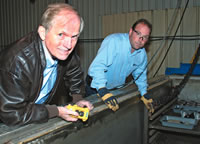 How much could be saved by quadrupling the life of bucket blades, drill bits, skip liners and all the other metal components and equipment used in a mining operation to extract and process ore? Millions? Tens of millions?
How much could be saved by quadrupling the life of bucket blades, drill bits, skip liners and all the other metal components and equipment used in a mining operation to extract and process ore? Millions? Tens of millions?
Dura 21, a Sudbury company specializing in cryogenic treatment, has unveiled a step-by-step process to introduce the technology to mining operations, estimate the opportunity for savings, implement a treatment regime and track the results.
Cryogenic treatment improves the wear resistance of metal objects by using liquid nitrogen to expose them to temperatures as low as -300 degrees Fahrenheit in a chamber resembling a large freezer.
Developed during World War Two and used extensively by NASA and the U.S. military, cryogenic treatment “has the ability to transform industries because of the cost savings that can be realized,” said Robert MacInnis, Dura 21 president.
MacInnis cites an example from the auto industry to make his point. A ball screw in a CNC machine at an engine plant was failing every three months, he said. “Every time it failed, they’d get 100 scrap engines that came out and five trades would have to go in and tear the thing down. The lost productivity was enormous.”
The ball screw was cryogenically treated and is still in service after 20 months.
“One treatment has saved them $400,000,” he said.
The cryogenic chamber at Dura 21’s Sudbury location is approximately 10 feet long, four feet wide and four feet deep, but “if there’s a big enough opportunity, you can design one to fit just about anything.”
Cryogenic treatment dramatically improves wear resistance by altering the molecular structure of metals.
MacInnis, a dentist from St. Catharines in southern Ontario’s Niagara region, learned about the process from a friend in the lumber business who cryogenically treated a Holtec saw, “an enormous chain saw” designed to cut through a skid of lumber.
“He went from 300 cuts to 1,100 cuts,” said MacInnis. “We were talking at dinner one night and I wondered if this would work on bearings used in dental drills.”
Bench testing turned him into a believer.
“We put treated and untreated bearings on a bench under load and we ran them until they failed. The one that was untreated went for 10 minutes and the one that was treated went 40 minutes.”
There are a few cryogenic treaters doing business on a retail basis, but hardly any methodical application of the process in larger industries, he said.
“They have a chamber, put things in, charge so much a pound. I’ve never been interested in just that sort of thing.”
Business model
MacInnis wondered why a technology with such a dramatic impact on durability received so little attention in industries such as mining. After thinking about it, he came to the conclusion that an appropriate business model had to be developed for enterprise-wide application of the technology.
MacInnis was referred to the Northern Centre for Advanced Technology in Sudbury and accepted into its residency program for new product development several years ago.
Sudbury, he said, was an ideal location because of the “obvious need in the mining and wood products industries.”
MacInnis tested a variety of mining-related items such as button bit and drill rods using a cryogenic chamber and developed a business model, the so-called six-step Duragenic process designed to introduce the technology to larger enterprises and track its results.
“One of the things we found when you go into industry is that nobody believes you,” he complained. “It sounds too good to be true because everybody these days wants to sell their product. You turn on the TV and everybody is selling the latest and greatest. They hear this 75 times a day and nobody believes you.”
MacInnis has also learned to be wary about testing cryogenically treated items in a production environment without rigourous tracking.
“We did one test at a mine and at the end of the day, they said, ‘Oh, we didn’t track it properly.’ A lot of times, they won’t even tell you they didn’t track it. They’ll just say they tried it and it didn’t work.
“We have to be careful because we don’t want to get a reputation out there that it doesn’t work.”
To help persuade skeptics, MacInnis provides potential customers with a promotional kit containing two disposable razors (one treated, one untreated) and a scorecard to compare the number of shaves they get.
Cryogenic treatment can also improve the wear resistance of gun barrels, golf clubs, brakes and ice skates, but Dura 21 is focusing on the bigger picture.
“Mining is going to be huge,” said MacInnis. “The industry is very comfortable now with the profit they’re generating, but they’re also very forward-thinking people. They’re not just sitting back in a status quo mode saying, ‘We’re comfortable. We’re happy.’ They’re still looking to protect themselves when prices go down again.”
Cryogenic treatment, according to field tests, can increase wear resistance by up to 817 per cent and trim costs by up to 90 per cent, depending on the tool type and material treated.

